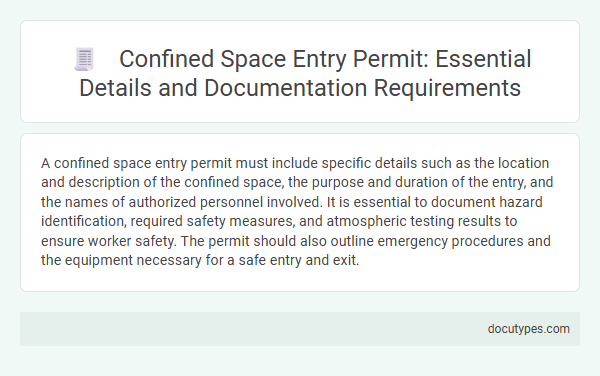A confined space entry permit must include specific details such as the location and description of the confined space, the purpose and duration of the entry, and the names of authorized personnel involved. It is essential to document hazard identification, required safety measures, and atmospheric testing results to ensure worker safety. The permit should also outline emergency procedures and the equipment necessary for a safe entry and exit.
Introduction to Confined Space Entry Permits
Confined space entry permits are critical documents designed to ensure the safety of workers entering hazardous spaces. These permits outline necessary precautions, responsibilities, and conditions to control risks effectively.
- Identification of the confined space - Precise description and location of the confined space must be included to avoid any confusion.
- Hazard assessment - A detailed evaluation of potential risks like toxic gases, oxygen deficiency, or engulfment hazards is required.
- Entry conditions and controls - Specific safety measures, monitoring procedures, and emergency protocols must be clearly stated.
Effective confined space entry permits serve as a legal and safety framework for protecting workers in hazardous environments.
Legal and Regulatory Framework
A confined space entry permit must include detailed information to comply with legal and regulatory frameworks established by agencies such as OSHA. These details ensure the safety of workers and compliance with workplace safety standards.
Key elements include identification of the confined space, potential hazards, and authorization signatures from a qualified supervisor. Additionally, the permit must specify atmospheric testing results, rescue procedures, and duration of the permit validity.
Definition of a Confined Space
A confined space is defined as an area that is large enough for a person to enter but has limited means of entry or exit and is not designed for continuous occupancy. Your confined space entry permit must include the identification of the space and a description of its hazardous characteristics. This ensures all potential risks are clearly communicated before entry occurs.
Key Components of an Entry Permit
A confined space entry permit ensures safety by documenting critical information before entry. These permits verify that all hazards are identified and control measures are in place.
- Identification of the Confined Space - Specifies the exact location and nature of the confined space to be entered.
- Hazard Assessment - Details potential risks such as toxic gases, oxygen deficiency, or engulfment hazards present in the space.
- Control Measures and Equipment - Lists required ventilation, monitoring instruments, and personal protective equipment essential for safe entry.
- Personnel Authorization - Names authorized entrants, attendants, and supervisors responsible for compliance and emergency response.
- Duration of Permit Validity - Defines the time frame during which the permit is effective and entry is allowed.
- Communication Procedures - Describes methods to maintain contact between entrants and attendants throughout the operation.
- Emergency and Rescue Plans - Outlines steps to be taken if a hazardous situation arises, including rescue team availability.
Your adherence to these key components ensures that confined space entry is managed safely and systematically.
Permit Approval and Authorization Process
The Permit Approval and Authorization Process for a Confined Space Entry Permit requires identification of the authorized personnel responsible for granting access to the confined space. It must include verification that all safety protocols, such as atmospheric testing and ventilation, have been completed prior to entry. The permit should also specify the duration of validity and conditions under which entry is allowed, ensuring strict compliance with regulatory standards.
Documentation Requirements for Permit Issuance
A confined space entry permit must include specific documentation details to ensure worker safety and regulatory compliance. Proper documentation facilitates hazard identification, controls implementation, and emergency preparedness before entry.
- Identification of Confined Space - The permit must clearly specify the location, type, and access points of the confined space to be entered.
- Hazard Assessment - Documentation should list potential hazards such as toxic gases, oxygen deficiency, or engulfment risks identified during pre-entry evaluation.
- Control Measures - The permit must detail required safety controls including ventilation, isolation, personal protective equipment, and monitoring procedures.
Responsibilities of Permit Issuer and Entrant
What details must be included in a confined space entry permit to ensure safety? The permit must specify the location, hazards, and duration of entry. It also outlines the required protective measures and emergency procedures.
What responsibilities does the permit issuer have in the confined space entry process? The permit issuer must verify that all safety protocols are in place and confirm hazard controls are effective before authorization. They are responsible for authorizing entry and monitoring ongoing compliance.
How should the entrant comply with the confined space entry permit? Entrants must follow all specified safety instructions and use the required personal protective equipment. They are responsible for reporting any unsafe conditions or incidents immediately to the permit issuer.
Permit Validity, Expiry, and Renewal Procedures
A confined space entry permit must clearly specify the permit validity period to ensure safe and controlled access. This includes the exact start and expiry times, aligning with the duration of the planned work inside the confined space.
Renewal procedures require a thorough reassessment of hazards before extending the permit beyond its initial expiry. Your safety protocols depend on strict adherence to these renewal steps to prevent unauthorized or unsafe entries.
Recordkeeping and Audit Compliance
A confined space entry permit must include detailed records of the personnel involved, the specific location and nature of the confined space, and the date and duration of entry. Accurate documentation ensures compliance with safety regulations and facilitates effective audit trails.
Recordkeeping requires logging atmospheric test results, equipment used, and hazard control measures implemented during the entry process. Maintaining these detailed entries supports regulatory audits by providing verifiable evidence of safety protocols. Properly documented permits help organizations demonstrate adherence to OSHA standards and internal safety policies.
What Details Must Be Included in a Confined Space Entry Permit? Infographic

